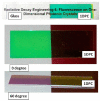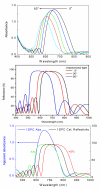Radiative decay engineering 6: fluorescence on one-dimensional photonic crystals
- PMID: 23896462
- PMCID: PMC4127491
- DOI: 10.1016/j.ab.2013.07.021
Radiative decay engineering 6: fluorescence on one-dimensional photonic crystals
Abstract
During the past decade the interactions of fluorophores with metallic particles and surfaces has become an active area of research. These near-field interactions of fluorophores with surface plasmons have resulted in increased brightness and directional emission. However, using metals has some disadvantages such as quenching at short fluorophore-metal distances and increased rates of energy dissipation due to lossy metals. These unfavorable effects are not expected in dielectrics. In this article, we describe the interactions of fluorophores with one-dimensional (1D) photonic crystals (PCs), which have alternating layers of dielectrics with dimensions that create a photonic band gap (PBG). Freely propagating light at the PBG wavelength will be reflected. However, similar to metals, we show that fluorophores within near-field distances of the 1DPC interacts with the structure. Our results demonstrate that these fluorophores can interact with both internal modes and Bloch surface waves (BSWs) of the 1DPC. For fluorophores on the surface of the 1DPC, the emission dominantly occurs through the 1DPC and into the substrate. We refer to these two phenomena together as Bragg grating-coupled emission (BGCE). Here we describe our preliminary results on BGCE. 1DPCs are simple to fabricate and can be handled and reused without damage. We believe that BGCE provides opportunities for new formats for fluorescence detection and sensing.
Keywords: Bragg grating-coupled emission; Near-field interactions; One-dimensional photonic crystals; Photonic band gap; Radiative decay engineering; Surface plasmon-coupled emission.
Copyright © 2013 Elsevier Inc. All rights reserved.
Figures





















References
-
- Deng W, Goldys EM. Plasmonic approach to enhanced fluorescence for applications in biotechnology and the life sciences. Langmuir. 2012;28:10152–10163. - PubMed
-
- Cao S-H, Cai W-P, Liu Q, Li Y-Q. Surface plasmon-coupled emission: What can directional fluorescence bring to the analytical sciences? Annu. Rev. Anal. Chem. 2012;5:317–36. - PubMed
-
- Lai C-F, Kuo H-C, Yu P, Lu T-C, Chao C-H, Yen H-H, Yeh W-Y. Highly-directional emission patterns based on near single guided mode extraction from GaN-based ultrathin microcavity light-emitting diodes with photonic crystals. Appl. Phys. Letts. 2010;97:0131808–1/3.
Publication types
MeSH terms
Substances
Grants and funding
LinkOut - more resources
Full Text Sources
Other Literature Sources
Miscellaneous

